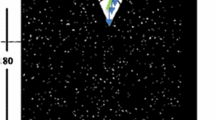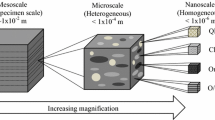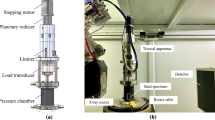Abstract
Determination of the mechanical properties of individual sand grains by conventional material testing methods at the macroscale is somewhat difficult due to the sizes of the individual sand particles (a few μm to mm). In this paper, we used the nanoindentation technique with a Berkovich tip to measure the Young’s modulus, hardness, and fracture toughness. An inverse problem solving approach was adopted to determine the stress-strain relationship of sand at the granular level using the finite element method. A cube-corner indenter tip was used to generate radial cracks, the lengths of which were used to determine the fracture toughness. Scatter in the data was observed, as is common with most brittle materials. In order to consider the overall mechanical behavior of the sand grains, statistical analysis of the mechanical properties data (including the variability in the properties) was conducted using the Weibull distribution function. This data can be used in the mesoscale simulations.









Similar content being viewed by others
References
Poorooshasb HB, Holubec I, Sherbourne AN (1966) Yielding and flow of sand in triaxial compression Part I. Can Geotech J 3(4):179–190
Lade PV, Duncan JM (1973) Cubical triaxial tests on cohesionless soil. J Soil Mech Found Div 99(10):793–812
Arthur JRF, Menzies BK (1972) Inherent anisotropy in a sand. Geotech 22(1):115–128
Lade PV, Prabucki MJ (1995) Softening and preshearing effects in sand. Soils Found 35(4):93–104
Wang Q, Lade PV (2001) Shear banding in true triaxial tests and its effect on failure in sand. J Eng Mech 127(8):754–761
Haythornthwaite R (1997) Simple shear in granular media. App Mech Rev 50(11):81–86
Goldenberg C, Goldhirsch I (2005) Friction enhances elasticity in granular solids. Nature 435:188–191
Geng J, Howell E, Behringer R, Reydellet G, Vanel L, Clement E, Luding S (2001) Footprints in sand: the response of a granular material to local perturbations. Phys Rev Lett 87(3):35506
Oda M, Konishi J, Nemat-Nasser S (1980) Some experimentally based fundamental results on the mechanical behavior of granular materials. Geotech 30:479
Desrues J, Lanier J, Stutz P (1985) Localization of the deformation in tests on sand sample. Eng Fract Mech 21(4):909–921
Oda M, Konishi J (1974) Microscopic deformation mechanism of granular material in simple shear. Soils Found 14(4):25–38
Liao JJ, Yang M-T, Hsieh H-Y (1996) Direct tensile behavior of a transversely isotropic rock. Int J Rock Mech Min Sci 34(5):837–849
Ulm F-J, Abousleiman Y (2006) The nanogranular nature of shale. Acta Geotech 1:77–88
Pethica JB, Hutchings R, Oliver WC (1983) Hardness measurement at penetration displacements as small as 20 nm. Philos Mag A 48:593–606
Oliver WC, Hutchings R, Pethica JB (1986) Measurement of hardness at indentation displacements as low as 20 nanometers. Microindentation Techniques in Materials Science and Engineering, ASTM STP 889, American Society for Testing and Materials. Philadelphia, 90–108
Li X, Bhushan B (2002) A review of nanoindentation continuous stiffness measurement technique and its applications. Mater Charact 48:11–36
Pethica JB, Oliver WC (1987) Tip surface interactions in STM and AFM. Phys Scripta T19:A61–A66
Doerner MF, Nix WD (1986) A method for interpreting the data from depth-sensing indentation instruments. J Mater Res 1:601–613
Oliver WC, Pharr GM (1992) An improved technique for determining hardness and elastic modulus using load and displacement sensing indentation experiments. J Mater Res 7:1564–1583
Liu Y, Wang B, Yoshino M, Roy S, Lu H, Komanduri R (2005) Combined numerical simulation and nanoindentation for determining mechanical properties of single crystal copper at mesoscale. J Mech Phys Solids 53:2718–2741
Liu Y, Varghese S, Ma J, Yoshino M, Lu H, Komanduri R (2008) Orientation effects in nanoindentation of single crystal copper. Intl J Plasticity 24:1990–2015
Antis GR, Chantikul P, Lawn BR, Marshall DB (1981) A critical evaluation of indentation techniques for measuring fracture toughness: I. Direct crack measurement. J Amer Ceram Soc 64:533–538
Pharr GM, Harding DS, Oliver WC (1993) Measurement of fracture toughness in thin films and small volumes using nanoindentation method. In: Nastasi M, Parkin DM, Gleiter H (eds) Mechanical properties and deformation behavior of materials having ultra-fine microstructures. Springer-Verlag, New York, pp 449–461
Jillavenkatesa A, Dapkunas SJ, Lin-Sien Lum (2001) Particle size characterization. NIST Special Publication 960–1
Prandtl L (1920) Ueber die haerte plasticher koerper. Goettinger Nachr, Math Phys Kl 74–85
Hill R, Lee EH, Tupper SJ (1947) The theory of combined plastic and elastic deformation with particular reference to a thick tube under internal pressure. Proc R Soc Lond A188:273
Ishlinskii AJ (1944) The axi-symmetrical problem in plasticity and the Brinell test. J Appl Math Mech 8:201
Shield RT (1955) Plastic flow of metals under conditions of axial symmetry. Proc R Soc Lond A233:267–287
Tabor D (1970) The hardness of solids. Rev Phys Technol 1:145–179
Johnson KL (1970) The correlation of indentation experiments. J Mech Phys Solids 18(2):115–126
Bhattacharya AK, Nix WD (1988) Finite element simulation of indentation experiments. Int J Solids Struct 24(9):881–891
Bhattacharya AK, Nix WD (1991) Finite element analysis of cone indentation. Int J Solids Struct 27(8):1047–1058
Wang HF, Bangert H (1993) Three-dimensional finite element simulation of Vickers indentation on coated systems. Mater Sci Eng A 163(1):43–50
Sun Y, Bell T, Zheng S (1995) Finite element analysis of the critical ratio of coating thickness to indentation depth for coating property measurements by nanoindentation. Thin Solid Films 258:198–204
Lichinchi M, Lenardi C, Haupt J, Vitali R (1998) Simulation of Berkovich nanoindentation experiments on thin films using finite element method. Thin Solid Films 1–2:240–248
Fivel MC, Robertson CF, Canova GR, Boulanger L (1998) Three-dimensional modeling of indent-induced plastic zone at a mesoscale. Acta Mater 46(17):6783–6194
Knapp JA, Follstaedt DM, Myers SM, Barbour JC, Friedmann TA, Ager JW, Monteiro OR, Brown IG (1998) Finite-element modeling of nanoindentation for evaluating mechanical properties of MEMS materials. Surf Coat Technol 103–104:268–275
Huang G, Lu H (2007) Measurements of two independent viscoelastic functions by nanoindentation. Special Issue- Nanoscale Measurements in Mechanics. Exp Mech 47:87–98
Huang G, Daphalapurkar N, Gan R, Lu H (2008) A method for measuring linearly viscoelastic properties of human tympanic membrane using nanoindentation. J Biomech Eng — Trans ASME 130:014501-1
Daphalapurkar N, Dai C, Gan R, Lu H (2009) Characterization of the Linearly Viscoelastic Behavior of Human Tympanic Membrane by Nanoindentation. J Mech Behav Biomed Mater 2:82–92
ABAQUS version 6.8 documentation (2008) Dassault Systèmes, Providence, RI
Dao M, Chollacoop N, Van Vliet KJ, Venkatesh TA, Suresh S (2001) Computational modeling of the forward and reverse problems in instrumented sharp indentation. Acta Mater 49:3899–3918
Harding DS, Oliver WC, Pharr GM (1995) Cracking during nanoindentation and its use in the measurement of fracture toughness. Mater Res Soc Symp Proc 356:663–668
Acknowledgements
This work is supported by an AFOSR DEPSCoR grant (FA9550-08-1-0328) and the authors acknowledge the strong support and interest of Dr. William L Cooper of the Air Force Research Laboratory, Eglin AFB, and Dr. Victor Giurgiutiu of the Air Force Office of Scientific Research (AFOSR). Additionally, H.L. acknowledges the support of NSF (CMMI-0555902 and CMS-9985060) and R.K. acknowledges the A.H. Nelson, Jr. Endowed Chair in Engineering for additional financial support. The authors also thank Mrs. Sharon Green for her highly skilled editorial assistance.
Author information
Authors and Affiliations
Corresponding author
Rights and permissions
About this article
Cite this article
Daphalapurkar, N.P., Wang, F., Fu, B. et al. Determination of Mechanical Properties of Sand Grains by Nanoindentation. Exp Mech 51, 719–728 (2011). https://doi.org/10.1007/s11340-010-9373-z
Received:
Accepted:
Published:
Issue Date:
DOI: https://doi.org/10.1007/s11340-010-9373-z




